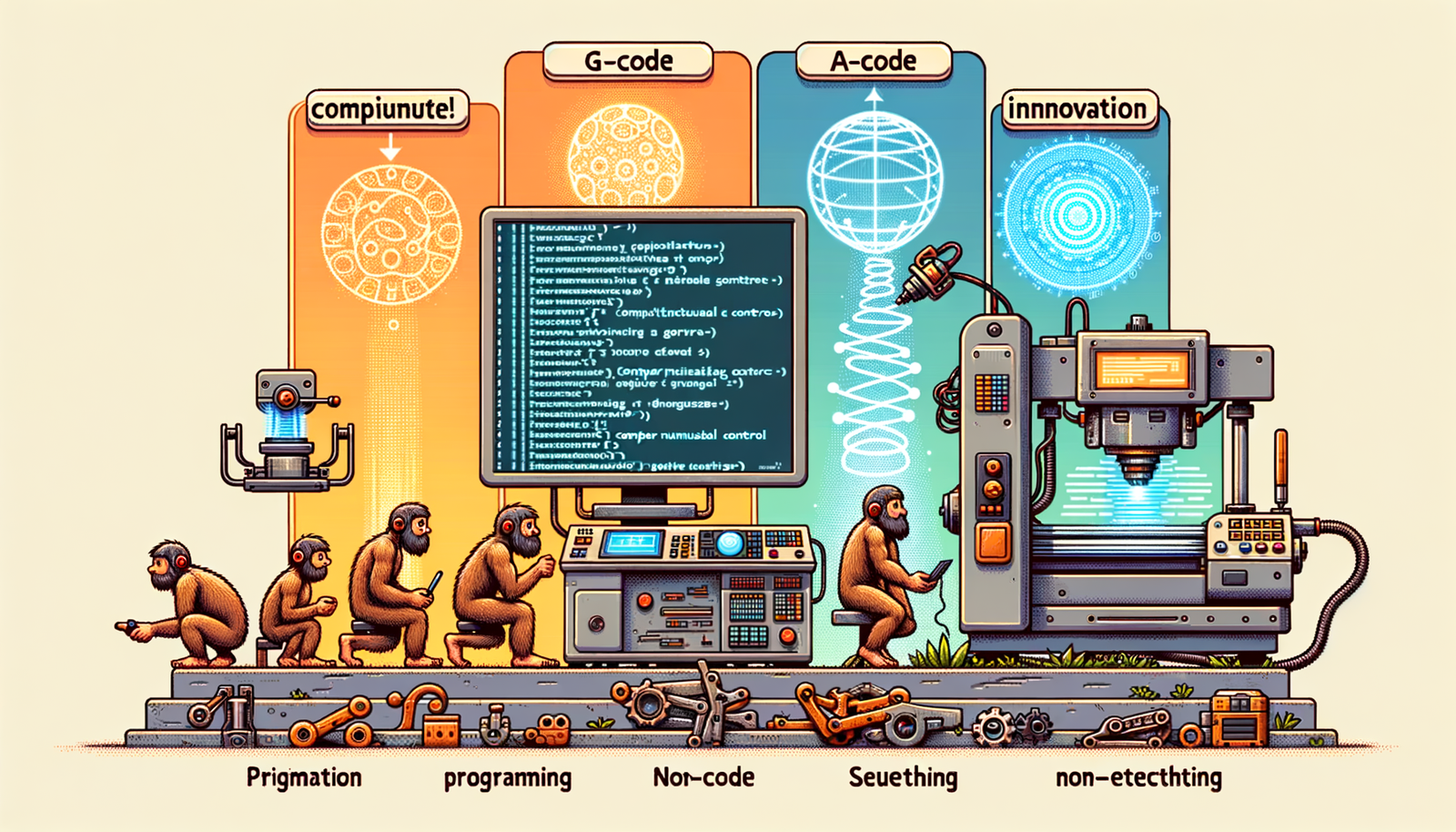Your Cart is Empty
Customer Testimonials
-
"Great customer service. The folks at Novedge were super helpful in navigating a somewhat complicated order including software upgrades and serial numbers in various stages of inactivity. They were friendly and helpful throughout the process.."
Ruben Ruckmark
"Quick & very helpful. We have been using Novedge for years and are very happy with their quick service when we need to make a purchase and excellent support resolving any issues."
Will Woodson
"Scott is the best. He reminds me about subscriptions dates, guides me in the correct direction for updates. He always responds promptly to me. He is literally the reason I continue to work with Novedge and will do so in the future."
Edward Mchugh
"Calvin Lok is “the man”. After my purchase of Sketchup 2021, he called me and provided step-by-step instructions to ease me through difficulties I was having with the setup of my new software."
Mike Borzage
Design Software History: Evolution of CNC Machining Software: From G-Code to AI-Driven Innovations
August 23, 2024 4 min read


Introduction to CNC Machining and Software Development
The field of Computer Numerical Control (CNC) machining has experienced a transformative evolution from its inception. With roots in manual machining, CNC machining leverages the power of software to control machine tools, leading to greater precision, efficiency, and capabilities.
Overview of CNC Machining
CNC machining refers to the automated control of machining tools by means of a computer. The basic principles involve using coded instructions (G-code) to control the movement of machinery. This technology has evolved from traditional manual machining methods, which required skilled operators to manually guide the cutting tools.
The transition from manual machining to CNC began in the mid-20th century, driven by the need for higher precision and repeatability in manufacturing processes. Early CNC systems utilized punched tape and rudimentary programming languages to control machine operations, laying the foundation for more sophisticated systems.
Early Software Development
The initial attempts at software control in CNC machining were rudimentary but groundbreaking. The introduction of G-code, a language developed to provide instructions to CNC machines, played a crucial role in the early systems. Pioneers such as John T. Parsons and MIT's Servomechanisms Laboratory were instrumental in developing these early CNC systems.
Pioneering companies like General Motors and MIT collaborated to create the first CNC machines. The groundbreaking work done by these early innovators set the stage for the development of more advanced CNC software that would revolutionize the manufacturing industry.
The Rise of CAM Software
Introduction to CAM (Computer-Aided Manufacturing)
Computer-Aided Manufacturing (CAM) refers to the use of software to control machine tools and related machinery in the manufacturing of workpieces. CAM software is essential in CNC machining as it translates the designs created in Computer-Aided Design (CAD) software into executable instructions for CNC machines.
The key difference between CAD and CAM lies in their roles: while CAD focuses on the design aspect, generating detailed models and blueprints, CAM is concerned with the manufacturing process, ensuring that the designs are accurately and efficiently produced.
Milestones in CAM Software Development
The development of CAM software has seen several significant milestones, beginning with the creation of the Automatically Programmed Tool (APT) language at MIT in the 1950s. APT was one of the first programming languages specifically designed for controlling CNC machines, allowing engineers to define complex tool paths and operations.
The integration of CAM software with CAD systems marked a significant advancement, enabling seamless transitions from design to manufacturing. Companies like IBM and Boeing were key players in this integration, developing systems that could handle complex geometries and optimize machining processes.
- IBM: Developed early CAM solutions that integrated with their mainframe computers, providing powerful tools for manufacturing automation.
- Boeing: Leveraged CAM software to enhance their aerospace manufacturing processes, achieving higher precision and efficiency.
Advanced Features and Modern Innovations
Enhancements in CNC Machining Software
Modern CNC machining software has introduced a plethora of advanced features that have significantly enhanced the capabilities of CNC machines. One of the most notable advancements is the introduction of 3D modeling and simulation, allowing engineers to visualize and test their designs before actual machining.
Toolpath optimization and collision detection are other critical enhancements. These features ensure that the CNC machines operate efficiently, minimizing tool wear and preventing collisions that could damage the machine or the workpiece.
Innovative Companies and Software
Several companies have been at the forefront of developing innovative CNC machining software. Notable examples include:
- Mastercam: Known for its powerful toolpath generation and comprehensive suite of features, Mastercam is widely used in various industries.
- SolidCAM: This software offers seamless integration with popular CAD systems like SolidWorks, providing robust CAM capabilities.
- Fusion 360: Developed by Autodesk, Fusion 360 combines CAD, CAM, and CAE (Computer-Aided Engineering) in a single platform, offering a unified solution for design and manufacturing.
Companies like Autodesk, Siemens, and PTC have made significant contributions to the field, driving innovation and pushing the boundaries of what CNC machining software can achieve.
Real-Time Monitoring and Feedback
The development of the Internet of Things (IoT) and smart manufacturing has introduced real-time monitoring and feedback capabilities in CNC machining. Real-time data collection from CNC machines allows for continuous monitoring of machine performance and early detection of potential issues.
Artificial Intelligence (AI) also plays a vital role in optimizing CNC operations. By analyzing data from multiple sources, AI algorithms can predict maintenance needs, optimize tool paths, and improve overall efficiency.
Impact on Industries and Future Directions
Impact on Various Industries
The impact of CNC machining software on various industries has been profound. In aerospace, automotive, and medical device manufacturing, CNC machining has led to significant improvements in efficiency, precision, and production capabilities.
Key industries benefiting from CNC machining software include:
- Aerospace: Enhanced precision and the ability to manufacture complex components have revolutionized aerospace manufacturing.
- Automotive: CNC machining software has enabled the production of high-precision parts, contributing to the development of safer and more efficient vehicles.
- Medical Devices: The high level of precision required in medical device manufacturing is achieved through advanced CNC machining software, ensuring the production of reliable and safe medical components.
Future Trends in CNC Machining Software
The future of CNC machining software is marked by several exciting trends and advancements. The integration of Augmented Reality (AR) and Virtual Reality (VR) for setup and training is becoming more prevalent, allowing operators to visualize and interact with complex machining processes in a virtual environment.
Continued advancements in AI and machine learning are expected to further enhance the capabilities of CNC machining software. These technologies will enable more intelligent decision-making, predictive maintenance, and optimization of machining processes.
Cloud computing and collaborative platforms are also poised to play a significant role in the future of CNC machining software. These platforms will facilitate real-time collaboration, data sharing, and integration with other manufacturing systems, driving greater efficiency and innovation.
Conclusion
Summary of Key Points
The evolution of CNC machining software from its early attempts to modern, sophisticated systems has been remarkable. The introduction of G-code, the development of CAM software, and the integration of advanced features like 3D modeling, simulation, and real-time monitoring have revolutionized the manufacturing industry.
Final Thoughts on the Future of CNC Machining Software
As we look to the future, anticipated technological advancements such as AI, machine learning, AR/VR, and cloud computing are expected to further transform CNC machining software. These innovations will continue to enhance precision, efficiency, and capabilities, driving progress in various industries and shaping the future of manufacturing.
Also in Design News

ZBrush Tip: Optimizing ZBrush Models with the Curve Bridge Brush Technique
January 15, 2025 2 min read
Read More
Revit Tip: Enhance Design Precision with Revit's Radial Array Tool
January 15, 2025 2 min read
Read More
AutoCAD Tip: Mastering AutoCAD's Revolve and Sweep Tools for Advanced 3D Modeling
January 15, 2025 2 min read
Read MoreSubscribe
Sign up to get the latest on sales, new releases and more …


